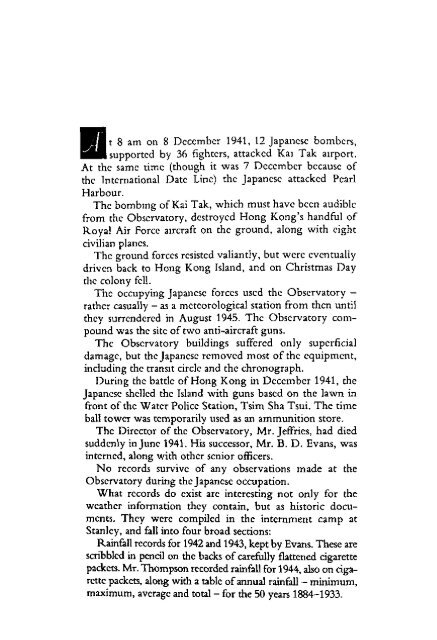Royal - HKU Libraries - The University of Hong Kong
Royal - HKU Libraries - The University of Hong Kong
Royal - HKU Libraries - The University of Hong Kong
Create successful ePaper yourself
Turn your PDF publications into a flip-book with our unique Google optimized e-Paper software.
It 8 am on 8 December 1941, 12 Japanese bombers,supported by 36 fighters, attacked Kai Tak airport.At the same time (though it was 7 December because <strong>of</strong>the International Date Line) the Japanese attacked PearlHarbour.<strong>The</strong> bombing <strong>of</strong> Kai Tak, which must have been audiblefrom the Observatory, destroyed <strong>Hong</strong> <strong>Kong</strong>'s handful <strong>of</strong><strong>Royal</strong> Air Force aircraft on the ground, along with eightcivilian planes.<strong>The</strong> ground forces resisted valiantly, but were eventuallydriven back to <strong>Hong</strong> <strong>Kong</strong> Island, and on Christmas Daythe colony fell.<strong>The</strong> occupying Japanese forces used the Observatory -rather casually - as a meteorological station from then untilthey surrendered in August 1945. <strong>The</strong> Observatory compoundwas the site <strong>of</strong> two anti-aircraft guns.<strong>The</strong> Observatory buildings suffered only superficialdamage, but the Japanese removed most <strong>of</strong> the equipment,including the transit circle and the chronograph.During the battle <strong>of</strong> <strong>Hong</strong> <strong>Kong</strong> in December 1941, theJapanese shelled the Island with guns based on the lawn infront <strong>of</strong> the Water Police Station, Tsim Sha Tsui. <strong>The</strong> timeball tower was temporarily used as an ammunition store.<strong>The</strong> Director <strong>of</strong> the Observatory, Mr. Jeffries, had diedsuddenly in June 1941. His successor, Mr. B. D. Evans, wasinterned, along with other senior <strong>of</strong>ficers.No records survive <strong>of</strong> any observations made at theObservatory during the Japanese occupation.What records do exist are interesting not only for theweather information they contain, but as historic documents.<strong>The</strong>y were compiled in the internment camp atStanley, and fall into four broad sections:Rainfall records for 1942 and 1943, kept by Evans. <strong>The</strong>se arescribbled in pencil on the backs <strong>of</strong> carefully flattened cigarettepackets. Mr, Thompson recorded rainfall for 1944, also on cigarettepackets, along with a table <strong>of</strong> annual rainfall - minimum,maximum, average and total - for the 50 years 1884-1933.
















